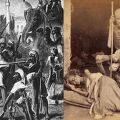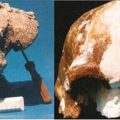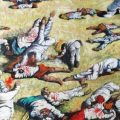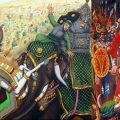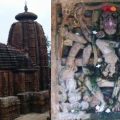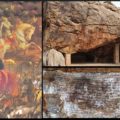British Forgery in Indian History: False Propaganda About Aśoka, Kalinga and Buddhism
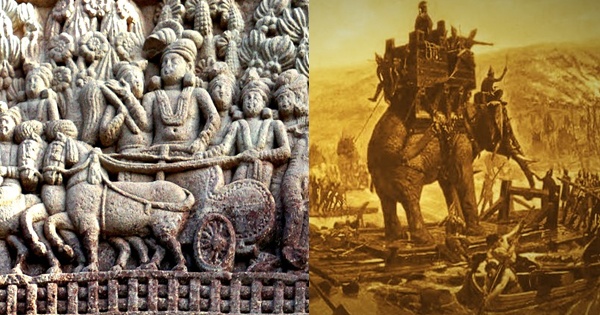
Nature and Aim of British Forgery
British forgery in Indian history was multifaceted and well declared, but is still considered authentic by Indians who refuse to leave mental slavery. There was a lot of false propaganda about history and its science, in which stories of Aśoka, Kalinga and Buddhism are most important. Main FALSEHOODS are-
(1) Indians did not write history -Actually, whatever history is written is totally from Indian literature though its major part was destroyed in 1000 years foreign rule.
(2) Indians did not give dates – Actually, Indians only have given dates. Date can be given only with reference to a calendar system. Even the time of Alexander’s attack had to be ascertained from Persian records, as Greece did not have any calendar at that time. Megasthenes has written that the first Greek attack was by Dionysus, 6451 years 3 months before Alexander in 154 generations of Indian kings. This count of generations or running calendar did not exist in any other country and this was based solely on Indian records.
(3) All Greek historians – Herodotus, Megasthenes, Solinu, Arrian, Pliny, Curtius have written that (a) India is only country where all persons are indigenous, (b) India had not attacked any country since last 15000 years as it was self sufficient in food. After Maxmuller copied 15000 years and reduced it 10 times to make 1500 BC as start of Indian Vedic civilization, this number was omitted from later editions. (c) There was continuous govt at least since 6777 BC when first Greek attack had occurred. (d) Reference to India meant that Greek attack was solely for looting, but it was shown to have given knowledge of science to India.
(4) All research was centered to destroy Indian records and praise in even western records to show that Britishers were just other foreigners like Indians themselves and had come for civilizing this country-not for looting. For that, excavation was made only in Indus valley and without bothering to know the meaning, arbitrary conclusions of date, migration of Aryans were made. Till today, westerns and even nationalists are obsessed with Indus civilization. Nationalism has changed the word to Sarasvatī-but we have stopped looking at our own language and records.
(5) There is no inscription seen anywhere in world which has given sequence and chronology of kings. Actually, no king can say that he died at such time and after him such and such became kings. These are found systematically in purāṇas only. After copying succession of kings from that, names of major kings who started calendars have been dropped and such kings have been made great who are nowhere mentioned in any literature or do not have any effect now. All Sanskrit students/teachers read works of Kālidāsa under Vikramāditya (Samvat in 57 BC) of Ujjain, Śūdraka (Śaka in 756 BC) and Śrīharṣa (Śaka in 456 BC) -but after lifelong reading, tell that there is no record about these kings as their calendars are still in use.
(6) There is only one chapter on Maurya Aśoka in Divyāvadāna, not a single line about any so-called great Gupta kings-but these are considered great. Samvat of Vikramāditya is still standard for deciding all festivals of India-not the so called Rāṣṭrīya-śaka-samvat started as copy of Roman calendar and there is10000 pages of literature on him-but that is not reference, as it can indicate correct time.
(7) Dhauli inscription of Aśoka is only about welfare and administration-it does not mention Kalinga war or anything about Buddha. But there were 10 million murders in North India as retaliation of 1857 revolt and further 3.5 million starvation murders in Orissa by Ravenshaw in 1865 when there was surplus production of rice. So, Vincent Smith created false story in 1893 (Ashok the Great) that hindus also were blood-thirsty and had killed /injured 10.5 lakhs in Kalinga war. Ashamed of being murderous hindu, Aśoka was converted to Buddhism. Romila Thapar (Asoka and the Decline of the Maurya) went a step ahead and described about downfall of India due to pacifist policy of Aśoka. All these are totally false, baseless and unimaginable.
Time of Aśoka
It was not something unknown and is written accurately in all purāṇas. Actually, there is no calendar in Europe prior to Julian calendar which can record his date. Carbon dating can indicate the date of any object with at least an error of 300 years for that period and even then a written record is needed to know that it was of time of Aśoka or Gupta period. All Indian calendar calculations start with Kali era beginning from 17-2-3102 BC, Wednesday, Ujjain midnight and even rough calculation by Vākyakaraṇa (charts memorized by sentences) has error of less than 15 minutes. Any calculation by calendar software of NASA will have error of up to 68 hours for 3100 BC. After 10 models of correction, error can be reduced to about 25 hours.
There are 2 Aśokas – one a Maurya king of Magadha and another a Gonanda king of Kashmir about same time. All purāṇas give list of Kaliyuga kings of Magadha, e.g. Bhāgavata purāṇa, skandha 11). They are-
1.Bārhadratha vamśa-Started with Somāpi, son of Sahadeva killed in Mahābhārata war.
(1) Somāpi (Mārjāri)-(3138-3080 BC), (2) Śrutaśravā (3080-3016 BC), (3) Apratīpa (3016-2980 BC), (4) Niramitra (2980-2940 BC), (5) Sukŗta (2940-2882 BC), (6) Bŗhatkarman (2882-2859 BC), (7) Senajita (2859-2809 BC), (8) Śrutañjaya (2809-2769 BC), (9) Mahābala (2769-2734 BC), (10) Śuchi (2734-2676 BC), (11) Kśema (2676-2648 BC), (12) Aņuvrata (2648-2584 BC), (13), Dharmanetra (2584-2549 BC), (14) Nirvŗtti (2549-2491 BC), (15) Suvrata (2491-2453 BC), (16) Dŗɖhasena (2453-2395 BC), (17) Sumati (2395-2362 BC), (18) Suchala (2362-2340BC), (19) Sunetra (2340-2300 BC), (20) Satyajita (2300-2217 BC), (21) Vīrajita (2217-2182 BC), (22) Ripuñjaya (2182-2132 BC) Total-22 kings for 1006 years (Brahmāņɖa purāņa 2/3/74/121, Vişņu purāņa 4/23/12 etc).
2. Pradyota vamśa-Last Bārhadratha king was Ripuñjaya killed by his minister Śunaka (or Pulaka) and made his son-in-law Pradyota, as king (Brahmāņɖa purāņa 2/3/74/122, Skanda purāņa 12/2 etc). (1) Pradyota (2132-2109 BC), (2) Pālaka (2109-2085 BC), (3) Viśākhayūpa (2085-2035 BC), (4) Janaka (2035-2014 BC), (5) Nandivardhana (2014-1994 BC)-Total 5 kings for 138 years.
3. Śiśunāga vamśa– (Kaliyuga Rāja Vŗttānta 2/2, Bhāgavata purāņa 12/2/8 etc.)-(1)Śiśunāga (1994-1954 BC), (2) Kākavarņa or Śakavarņa (1954-1918 BC), (3) Kśemadhanvā (1918-1892 BC), (4) Kśatrauja (1892-1852 BC), (5) Vidhisāra (Bimbisāra) or Śreņika (1852-1814 BC), (6) Ajātaśatru (1814-1787 BC), (7) Darśaka (1787-1752 BC), (8) Udāyi (1752-1719 BC), (9) Nandivardhana (1719-1677 BC), (10) Mahānandi (1677-1634 BC). In this period Siddhārtha, son of Śuddhodana became Buddha, who was incarnation of māyā and moha, not of Vişņu (Vişņu purāņa 4/23 etc). He was 5 years younger to Bimbisāra and died in 8th year of Ajātaśatru’s rule in 1806 BC. Udāyi in 4 year of his rule established Pāţaliputra on confluence of Son and Gangā (Vāyu purāņa 119/318).
Ten kings of this dynasty ruled for 360 years.
4. Nanda vamśa– Mahā-Padma-Nanda was the son of last Śiśunāga king Mahānandi by his śūdrā wife. After death of his father he became king 1500 years (more accurately 1534 years after birth of Parīkśita in 3138 BC) stated in all purāņas as a landmark of history. He won most of India by exterminating all kśatriya kings like second Paraśurāma. (Vişņu purāņa 4/24/104, Bhāgavata purāņa 12/1/10). He ruled for 88 years followed by 8 sons for 12 years (Matsya purāņa 270/20, 273/23)-a total of 100 years from 1634 to 1534 BC.
5. Maurya vamśa–Kauţilya Chāņakya destroyed and made Chandragupta as king. His family belonged to Murā town (in Sambalpur of Orissa, now submerged in Hirakud reservoir) which was center of iron ore called mura (murrum). So the family was called Maurya. 12 Maurya kings ruled for a total of 316 years (Kaliyuga Rāja Vŗttānta 3/2, Matsya purāņa 270/32, Vāyu purāņa etc.)- (1) Chandragupta (1534-1500 BC), (2) Bindusāra (1500-1472 BC), (3) Aśoka (1472-1436 BC), (4) Supārśva (Suyaśa, or Kuņāla)- (1436-1428 BC), (5) Daśaratha (Bandhupālita)-(1428-1420 BC), (6) Indrapālita (1420-1350 BC), (7) Harşavardhana (1350-1342 BC), (8) Sangata (1342-1333 BC), (9) Śāliśūka (1333-1320 BC), (10) Soma (Deva-) śarmā (1320-1313 BC), (11) Śatadhanvā (1313-1305), (12) Bŗhadratha (Bŗhadaśva)-(1305-1218 BC).
6.Śunga-Vamśa-10 Śunga kings ruled for 300 years (Kaliyuga Rāja Vŗttānta, Matsya, Vāyu purāņa).
(1) Puśyamitra (1218-1158 BC), (2) Agnimitra (1158-1108 BC), (3) Vasumitra (1108-1072 BC), (4) Sujyeşţha (1072-1055 BC), (5) Bhadraka (1055-1025 BC), (6) Pulindaka (1025-992 BC), (7) Ghoşavasu (992-989 BC), (8) Vajramitra (989-960 BC), (9) Bhāgavata (960-928 BC), (10) Devabhūti (928-918 BC).
7. Kaņva–Vamśa-4 Kaņva kings ruled for 85 years ((Vişņu purāņa 4/24/39-42 etc).
(1) Vāsudeva (918-879 BC), (2) Bhūmimitra (879-855 BC), (3) Nārāyaņa (855-843 BC), (4) Suśarmā (843-833 BC).
8. Āndhra–Vamśa-33 Āndhra kings ruled for 506 years. During that rule, saptarşi-cycle of 2700 years started in time of kingYudhişţhira (saptarşi in Maghā from 3176 BC)-(Matsya purāņa chapter 270 etc.). Detailed list is in Kaliyuga Rāja Vŗttānta, list in other purāņas miss some names.
(1) Śimukha (Sindhuka or Sumukha)-(833-810 BC), (2) Śrīkŗşņa Śātakarņī (810-792 BC), (3) Śrīmalla Śātakarņī (792-782 BC), (4) Pūrņotsanga (782-764 BC)-In his time Kalinga king Khārāvela became independent from Magadha which was suffering under attack from west Asia. He repaired Prāchī canal in 5th year of his rule (Prāchī inscription) which was 803 (Tri-vasu-śata ) years after coronation of Nanda (1634 BC), thus his rule started in 1634-(803-4) = 835 BC. (5) Śrī Śātakarņī (764-708 BC), (6) Skandha-stambin (Śrīvasvanī)-(708-690 BC), (7) Lambodara (690-672 BC), (8) Āpilaka (672-660 BC), (9) Megha-Svāti (660-642 BC), (10) Śāta-Svāti (642-624 BC), (11) Skanda-Svāti (624-617 BC), (12) Mŗgendra-Svāti-Karņa (617-614 BC), (13) Kuntala (614-606 BC), (14) Saumya (606-594 BC), (15) Śata-Svāti-Karņa (594-593 BC), (16) Pulomāvi-1 (593-557 BC), (17) Megha (557-519 BC), (18) Arişţa (519-494 BC), (19) Hāla (494-489 BC)-author of Gāthā-sapta-śatī, contemporary of Śankarāchārya. (20) Maņɖalaka (489-484 BC), (21) Purandara-Sena (484-463 BC)- saptarşi-cycle completed in 476 BC in his period. (22) Sundara- Śātakarņī (463-462 BC), (23) Chakra-Vāsişţhī-Putra and Mahendra (462-461 BC), (24) Śiva-1 (461-433 BC),(25) Gautamī-Putra–Śātakarņī (433-408 BC), (26) Pulomāvi-2 (408-376 BC), (27) Śiva-2 (376-369 BC), (28) Śivakoņɖā ( 369-362 BC), (29) Yajñaśrī (362-343 BC), (30) Vijayaśrī (343-337 BC), (31) Chandraśrī (337-334 BC), (32) Pulomāvi-3 (334-327 BC)-He was a child son of Chandraśrī whose queen had links with commander Chandragupta who killed the king and kept his infant son as namesake king. His father Ghaţotkacha-Gupta was commander to 2 kings-(30) Vijayaśrī and (31) Chandraśrī. Finally, Chandragupta killed the son also and became the king himself.
9. Gupta-Vamśa-They have been called Āndhra-bhŗtya also, as they were serving as commander under them (Matsya purāņa 273/17). Their place is called Śrī-Parvata which should be Śrī-śailam of Andhra Pradesh as the kings were from that area, not of Nepal as surmised. At start of this rule, Alexander attacked India in 326 BC. His historians have mentioned last kings of Āndhra and first 2 kings of Gupta clan as well as strength of army of Āndhra kings. Names as mentioned by Megasthenes are-Ghaţotkacha (Ghaţa = head, Utkacha = remover of hairs) – barber,
Chandraśrī. (Chandra-Bīja)—Agrammas (Xandrammas)-31st. Āndhra king
Chandragupta-1-Sandrocottus, Samudragupta-Sandrocryptus,
Chandragupta-2 was famous as conqueror or Amitrocchedas (= wiping out enemies)-Amitrochades.
Gupta kings adopted titles of earlier great kings of Maurya period-Chandragupta-1-Vijayāditya. Samudragupta–Aśokāditya, Chandragupta-2-Vikramāditya. This was only a title. Famous Paramāra king of Ujjain of this name was later on.
Śrīgupta was father of Ghaţotkacha or himself named as such due to bald head. His son Chandragupta-1 (327-320 BC) became first independent king. His first son Kacha (320 BC) was removed shortly due to his cowardice and Samudragupta (Aśokāditya (320-269 BC) took over. His elder son Rāmagupta offered his wfe to Śaka invader, so his wife married younger brother Chandragupta-2 (Vikramāditya) who killed invader and ruled in (269-233 BC). His son Kumāragupta-1 (233-191 BC) and then Skandagupta (191-175 BC) ruled. He died Issueless. His brother Puragupta ruled as guardian of Budhagupta followed byVainyagupta (175-174 BC), Kumāragupta-2 (174-172 BC), Budhagupta (172-166 BC) of same generation. Then Narasimhagupta (Bālāditya-1)- (166-126 BC) maintained some prestige and it declined with Kumāragupta-3 (126-85 BC), ending with Vişņugupta (85-82 BC).
False quoting of Greeks
Megasthenes had come at start of Gupta period which was known to Vincent Smith (Early History of India, page 206) and R.C. Mazumdar (Ancient India, page 138) also who have quoted him to give strength of army of Andhra kings. This is possible only when he had come in period of Gupta who were Andhra-bhritya (i.e. servants of Andhra kings at capital Patna). In Period of Ashoka, his 13th pillar inscription is clear that Andhra was a subordinate state. In all web-sites of Andhra Pradesh, it is quoted for glory of Andhra, but for general history, they all revert back to Megasthenes in Maurya period. Sri Mazumdar omitted this reference in his later 3 volume book in collaboration with K.K. Dutta and H.C. Raychaudhuri. For this obedience to Oxford by telling falsehood, he was made general editor of 12 volume history by Bharatiya Vidya Bhawan. Some links-
(1) www.bihar.cc/index.php?article=an-article-on-patna –9k- Sri R,C. Mazumdar in his ancient India (page 138) has written that Pliny has quoted Megasthenese for giving strength of Army of Andhra kings. …
(2) The early history of India By Vincent A. Smith Page 206
(3) vepachedu.org
Megasthenese, who visited the Court of Chandragupta Maurya (B.C.322–297), mentioned that Andhra country had 30 fortified towns and an army of 1,00,000 infantry, 2,000 cavalry and 1,000 elephants. Ashoka referred in his 13th rock edict that Andhras were his subordinates.
(5) http://en.wikipedia.org/wiki/Andhra_Pradesh.
Extracts from Megasthenes: Quotes from Indika is from this website.
(37.) India,… Owing to this, their country has never been conquered by any foreign king: (38.) It is said that India, being of enormous size when taken as a whole, is peopled by races both numerous and diverse, of which not even one was originally of foreign descent, but all were evidently indigenous; and moreover that India neither received a colony from abroad, nor sent out a colony to any other nation.
(39.) Herakles also was born among them…. He was the founder, also, of no small number of cities, the most renowned and greatest of which he called Palibothra.
FRAGM. LVI. Plin. Hist. Nat. VI. 21. 8-23. 11. List of the Indian Races.
(22.) …The river Jomanes flows through the Palibothri into the Ganges between the towns Methora and Carisobora
BOOK IV. FRAGM. XLVI. Strab. XV. I 6-8,–pp. 686-688.
- But what just reliance …….Its people, he says, never sent an expedition abroad, nor was their country ever invaded and conquered except by Herakles and Dionysos in old times, and by the Makedonians in our own…. Herakles among the Greeks, carried his arms to the Pillars
FRAGM. L. C. Plin. Hist. Nat.VI. xxi. 4-5. Of the Ancient History of the Indians.
For the Indians stand almost alone among the nations in never having migrated from their own country. From the days of Father Bacchus to Alexander the Great, their kings are reckoned at 154, whose reigns extend over 6451 years and 3 months.
Solin. 52. 5.– Father Bacchus was the first who invaded India, and was the first of all who triumphed over the vanquished Indians. From him to Alexander the Great 6451 years are reckoned with 3 months additional, the calculation being made by counting the, kings who reigned in the intermediate period, to the number of 153.
Archive on Megasthenes and Arrian.
- Same as (38) above.
Ancient India as described by Arrian
[Excerpted from Arrian, “The Indica” in Anabasis of Alexander, together with the Indica, E. J. Chinnock, tr. (London: Bohn, 1893), ch. 1-16]
From Dionysus to Sandracottus the Indians reckoned 153 kings, and 6,042 years. During all these years they only twice asserted their freedom; the first time they enjoyed it for 300 years, and the second for 120. They say that Dionysus was earlier than Heracles by fifteen generations, and that no other ever invaded India for war, not even Cyrus, the son of Cambyses, though he marched against the Scythians, and in other matters was the most meddlesome of the kings of Asia. However they admit that Alexander came and overcame in battle all the nations whom he visited, and that he would have conquered them all if his army had been willing. But none of the Indians ever marched out of their own country for war, being actuated by a respect for justice.
Kalinga War and Buddha
There was another Aśoka in Gonanda-vamśa (43rd king) in (1448-1400 BC) who had become Bauddha due to which Bauddhas from central Asia destroyed the kingdom. After that his son Jalauka (1400-1344BC) chased away bauddhas and re-established Chāturvarṇya (Vedic path). The place where bauddhas and their west Asian associates were routed was called Ujjhaṭaḍīmba (= uprooting the seed).
(राजतरङ्गिणी, तरङ्ग १)-
प्रपौत्रः शकुनेस्तस्य भूपतेः प्रपितृव्यजः। अथावहदशोकाख्यः सत्यसन्धो वसुन्धराम्॥१०१॥
यः शान्तवृजिनो राजा प्रपन्नो जिनशासनम्। शुष्कलेत्र वितस्तात्रौ तस्तारस्तूपमण्डलैः॥१०२॥
म्लेच्छैः संछादिते देशे स तदुच्छितये नृपः।१०७। सोऽथभूभृज्जलौकोऽभूद् भूलोकसुरनायकः।१०८।
स रुद्ध वसुधान् म्लेच्छान् निर्वास्याखर्व विक्रमः।११५।
ते यत्रोज्झटितास्तेन म्लेच्छाश्छादित मण्डलाः। स्थानमुज्झटडिम्बं तज्ज्नैरद्यापि गद्यते।११६।
जित्वोर्वीं कान्यकुब्जाद्यां तत्त्रत्यं स न्यवेशयत्। चातुर्वर्ण्यं निजे देशे धर्म्यांश्च व्यवहारिणः।११७॥
Many of the inscriptions in name of Aśoka are by him. No inscription including one at Dhauli mentions that he had become Buddhist.
Inscription at Kalsi near Dehradun gives names of 4 kings who were won by Aśoka–Tulamaya, Antikina, Maka, Allikasudala. One of them must be the king of Kalinga, won in 8th year of his rule. That is Alekha-sundara of Kalinga. Alakha name is all over India, but Alekha is only in Orissa because lokapāla of east was Indra who was called Lekharṣabha for starting Deva-nāgarī script (Mārkaṇḍeya purāṇa chapter 103, Taittirīya samhitā 6/4/7, Maitrāyaṇī samhitā, 4/5/8). He cannot be equated with any king of Alexandria, as it was never a part of India or under Aśoka. The town itself did not exist in 1450 BC.
Only mention of Aśoka is in Bauddha text Divyāvadāna (chapter Aśokāvadāna) that Aśoka was a good Bauddha because he had killed 12,000 Jaina monks on victory over Kalinga. This is too high a figure for a normal war. There is no basis of figure of 1,50,000 killed, 350,000 injured and 550, 000 arrested. This exceeds the population of the then Kalinga and more than current strength of Indian army. Alexander Army was only 120,000 with 20,000 horses, which was afraid of Magadha army of 600,000. Only possibility may be that Jainas might be powerful in Kalinga administration which was lost after war. This falsehood was created by Vincent Smith in 1893 to counter 35 lakh murders by Ravenshaw who has become father figure of Oriya nationalism in tradition of British slavery. Another fallacy is spread that Magadha empire was destroyed due to adoption of non-violence by Aśoka. Actually, non-violence is feature of Yoga-sūtra and more stressed in Jainism. Rather, Bauddha themselves including Siddhārtha Buddha himself were strongly opposed to vegetarian food even for Bhikśus. It is surprising as to how Buddha was moved by sacrifice of animals in yajña, which is for food, not for God. He expelled Devadatta for recommending vegetarian food for Bhikśus (extract from link below). Due to excess meat eating, Siddhārtha Buddha was operated by Jīvaka who strongly prohibited further meat eating. But he took it when a disciple offered it at Sarnath and he expired (Buddha-Charita of Aśvaghoṣa).
Devadatta requested the Buddha to make it compulsory for monks to follow five extra rules:
(i) Dwell all their lives in the forest
(ii) Live only on alms obtained by begging
(iii) Wear robes made from rags collected from the dust heaps and cemeteries
(iv) Live at the foot of trees
(v) Refrain from eating fish or meat throughout their lives.
Maurya kings were never against Brāhmaņas, minister of Last king Puśyamitra was himself a Brāhmaņa who killed king and became king himself.
The years of each king has been reduced suitably by Pargiter to match his reduced chronology. E.g. Maurya from 316 years to 137 years and number of kings reduced from 12 to 9 (verse 149) He did not understand or cared for saptarṣi era and missed the total number of years given later- Verse 227 tells 1500 (1504) years from Parīkśita to Mahāpadmananda. This number has been reduced to 1050 which is obviously false as Bārhadratha vamśa itself ruled for 1000 (1006) years followed by Pradyotas for 138 and Śiśunāga for 360 before Nanda as given in details. It also indicates that a cycle of Saptarṣi years of 2700 years was completed from Parīkśita to end last part of Āndhra kings (3042 BC-2700 = 342 BC) after which Gupta rule started in 327 BC. Pargiter and William Jones missed Kaliyuga Rāja Vṛttānta-a subsidiary of Bhavishya purāṇa. That has given complete chronology.
Similar manipulation was done in Matsya purāṇa whose original version tallies with that. Original copies available with Narayana Sastry were destroyed later on.
T.S. Narayana Sastry writes:- “Fortunately in my library (T.S.Narayana Sastry’s Library), I possess a manuscript copy of Matsya Purana in Grantha Character, which gives a complete list of the Maurya kings with years of individual reigns and I give the same below:-
चतुस्त्रिंशत् समा राजा चन्द्रगुप्तो भविष्यति। अष्टाविंशति वर्षाणि भद्रसारस्तु तत् सुतः।२४।
षट् त्रिंशत्तु महाराजो भविताऽशोक एव च। तस्य पुनः कुनालस्तु वर्षाण्यष्टौ भविष्यति।२५।
कुनालसूनुरष्टौ च भोक्ता दशरथस्ततः। सप्तानां दशवर्षाणि तत्सुतश्चेन्द्रपालितः।२६।
भविता चाऽष्टवर्षाणि तत्सुतो हर्षवर्धनः। भविता नववर्षाणि तस्य पुत्रस्तु सम्मतः।२७।
त्रयोदश हि वर्षाणि शालिशूको भविष्यति। भविता सप्तवर्षाणि सोमशर्मा नराधिपः।२८।
भविता शतधन्वा तु नववर्षाणि तत्सुतः। बृहद्रथस्तु वर्षाणि तस्य पुत्रोऽथ सप्ततिः।२९।
इत्येते दश च द्वे च ये भोक्ष्यन्ति वसुन्धराम्। शतानि त्रीणि वर्षाणि तेभ्यः शुङ्गान् गमिष्यति।३०।
This version of Matsya purāṇa tolerably agrees with that given in the manuscript copy of the Kaliyuga Raja Vrittanta, in my library which also I add below for easy reference-
चन्द्रगुप्तस्ततो मौर्यश्चाणक्येनाऽभिरक्षितः। चतुस्त्रिंशत् समा राज्यं करिष्यति सुधार्मिकः॥
अष्टाविंशति सहस्राणि विन्दुसारो भविष्यति। षट् त्रिंशस्तु ततो राजा भविताऽशोकवर्धनः॥
सुपार्श्व स्तत्सुतश्चाऽथ वर्षाण्यष्टौ भविष्यति। अष्टौ वर्षाणि तत्पुत्रो भोक्ता वै बन्धुपालितः।।
बन्धुपालितदायादो सप्ततिं चेन्द्रपालितः। भविता नववर्षाणि तस्य पुत्रस्तु संगतः॥
त्रयोदश समा राज्यं शालिशूकः करिष्यति। भविता सप्तवर्षाणि देवधर्मा नरर्षभः॥
ततः शतधनू राजा भविताऽष्टौ समा भुवि। बॄहद्रथस्तु तत्पुत्रो जरासन्ध इवाऽपरः॥
क्षत्रियानखिलान् जित्वा महाराजो भविष्यति। अष्टाशीतिं तु वर्षाणि स राष्ट्रं पालयिष्यति॥
द्वादशैते नृपा मौर्या श्चन्द्रगुप्तादयो महीं। शतानि त्रीणि भोक्ष्यन्ति दशषट् च समा कलौ॥ (भाग ३, अध्याय २)
Vide “Age of Sankara”, part IB, Appendix I, page 56ff)
Origin of Mauryas
Maurya is derived from word Mura which means iron ore powder-it is called murrum or red-brown soil put on earthen roads. There were 2 famous regions of-Mura. One was Morocco, land of Moors. King of that are was killed by Kṛṣṇa, so he was called Murāri. His town had 100 Yojana (about 800 kms) iron fencing, so he was called Mura as in Viṣṇu purāṇa (5/29/16-17). विष्णु पुराण (५/२९)-
प्राग्ज्योतिषपुरस्यापि समन्ताच्छतजोजनम्। आचिता मौरवैः पाशैः क्षुरान्तैर्भूर्द्विजोत्तम॥१६॥
तांश्चिच्छेद ह्रिः पाशान्क्षिप्त्वा चक्रं सुदर्शन। ततो मुरस्समुत्तस्थौ तं जघान च केशवः॥१७॥
Same is in Bhāgavata purāṇa (10/59/3-5) etc. Durgā-saptaśatī (8/6) calls them Maurya.
Centre of iron ore region from Korba to Tatanagar was called Murā town. It was on bank of Mahanadi and was also called Mura-sīma-pattana (being a river port). This was regional capital of Pāṇḍu-vamśī kings ruling from Suvarṇapur (Sonepur) in west Odisha. This town submerged in Hirakud reservoir in 1956 after a dam was built. Other 2 regions under them were Kalinga with capital at Koṇa-gaḍha and Utkal with capital at Vijaya-kaṭaka (present Cuttack). Labourers of iron mines were called Muṇḍā which is tribal title. Local branch of Atharva-veda here was called Muṇḍaka whose upaniṣad survives. Brāhmaṇas of that branch have Muṇḍa title. At least 50 grants by Mauryas are published in Orissa Inscriptions in 5 volumes by Odisha museum. Most are with dates in an era starting with Vijaya Samvasara of Janamejaya. Digvijaya-śāsana of Janamejaya gives date by al, 5 methods of Indian calendar and is of 27-11-3014 BC when a solar eclipse had occurred. The same format of grants was adopted by Pāṇḍu-vamśī kings who have used Vijaya samvatsara starting from 3013 BC. Digvijaya-śāsana and 4 grants of Janamejaya were published in Mysore Antiquary in January 1900 with accurate dates, but by British manipulation, date of 27-11-3014 BC was changed to 1526 AD-an error of 4540 years. In Odisha history, Pāṇḍu-vamśī kings have been described in period of Harṣavardhan (605-647 AD) when he himself was king of Odisha also and had performed ratha-yātrā in 635 and 642 AD described by Huensang. In same period 3 more kingdoms have been stated-Ganga or Choḍa-Ganga, Māṭhar, Sarabhapuriyā.
All grants by Janamejaya and his descendants use the following verses-
आदित्यचन्द्रावनिलोऽनलश्च द्यौर्भूमिरापो हृदयं यमश्च ।
अहश्च रात्रिश्च उभे च सन्ध्ये धर्मश्च जानाति नरस्य वृत्तं ॥२॥
दानपालनयोर्मध्ये दानाच्छ्रेयोऽनुपालनं । दानात्स्वर्गमवाप्नोति पालनाद्विगुणंफलं ॥
स्वदत्ताद् द्विगुणं पुण्यं परदत्तानुपालने । परदत्तापहारेण स्वदत्तं निष्फलं भवेत् ॥
मद्दत्ता पुत्रिका ज्ञेया पितृदत्ता सहोदरी । अन्यदत्ता तु जननी दत्तभूमिं परित्यजेत् ॥
अन्यैस्तु छर्दितं छद्वे श्वभिश्च छर्दितं न तु । ततः कष्टो ततो नीचः स्वदत्तापहारकः ॥
स्वदत्तां परदत्तां वा ब्रह्मवृत्तिं हरेत यः । षष्टिवर्षसहस्राणि विष्टायां जायते कृमिः ॥
There are 10 witnesses to grant-sun, moon, fire, wind, sky, earth, water, heart, Yama, day, night, both Sandhyā (morning, evening), Dharma. Honouring grant is more important than giving it. One who usurps grant is born as insect in excreta.
Kedarnath grant of Janamejaya still survives given on occasion of solar eclipse at Puri on 27-11-3014 BC as repentance of mass killing in Naga-kingdom (remains are Harappa = heap of bones, Moin-jo-Daro = place of dead). This was published in January 1900 in Mysore Antiquary.
Salient lines are- स्वस्तिश्री जयाभ्युदये युधिष्ठिरशके प्लवङ्गाख्ये एकोननवतितम (८९) वत्सरे सहसिमासि अमावास्यायां सोमवासरे श्रीमन्महाराजाधिराज परमेश्वर वैयाघ्रपादगोत्रज श्रीजनमेजयभूपो इन्द्रप्रस्थ नगरीसिंहासनस्थः सकलवर्णाश्रमधर्मप्रतिपालको उत्तरहिमालये श्रीकेदारक्षेत्रं तत्रत्य मुनयः उषामठस्य श्रीगोस्वामि आनन्दलिंग जंगमाय श्रीमच्छिष्यज्ञानलिंगजंगमद्वाराराधित श्रीकेदारनाथस्य पूजार्थं दत्तवन्तः चतुःसीमा परिमिति क्रमः॥ पूर्वभागे दक्षिणवाहिनी मन्दाकिनी । पश्चिम दक्षिणभागे क्षीरगङ्गा उत्तर पश्चिमे मधुगङ्गा, पूर्वोत्तरभागे स्वर्गद्वारनदी, दक्षिणे सरस्वती, मन्दाकिन्योः संगमः, एतन्मध्ये श्रीकेदारक्षेत्रं भवच्छिष्यपरम्परया चन्द्रार्कपर्यन्तं निधि निक्षेप जल पाषाणा गामि सिद्ध साध्य तेजः स्वाम्य सहितं स्वबुद्ध्याऽनुकूल्येनाऽ स्मन्मातृपितृणां शिवलोक प्राप्त्यर्थं श्रीकेदार सन्निधौ उपराग समये सहिरण्य मन्दाकिनी जलधारा पूर्वकं क्षेत्रमिदं हस्ते दत्तवानस्मि ।
Digvijaya (victory) śāsana gives place names of Odisha, Kaṭaka, kacchhapuṭ (Koraput?), Racchapuṭ, Kongaḍa. It calls king of Utkala as Aśvapati, Kalinga king as Gajapati. Gajapati title still survives. Janamejaya has called his Gotra as Vyāghrapada whose descendants are called Baghel now in Odisha.
स्वस्ति समस्त भुवनाश्रय श्रीपृथ्वीधरवल्लभ महाराजाधिराज राजपरमेश्वर परमभट्टारक हस्तिनापुर वराधीर आरोहक मगदन्त रिपुरायकान्वादान्त वैरि-वैधव्य पाण्डव-कुल-कमल-मार्त्तण्ड कदनप्रचण्ड कलिंग-कोदण्ड मार्त्तण्ड एकावीर रणरङ्गधीर अश्वपतिराय दिक्पति-राजपति-राय-संहारक नरपतिराय दिक्पति-गजपति-राय-संहारक मस्तक तलत्र हरि सामन्त मृग चामूर कोङ्गण चातुर्दिग भय रच्छपुट काच्छपुट ई वरमुख कमल-विनिर्गत-ब्रह्मवीणादि भरतशास्त्र प्रसिद्ध अनेकास्त्र प्रवीण कोरण्ड व्यालि नागार्जुनादि मन्त्र-त्रय-शुद्ध प्रसिद्ध समुदाय नमित पादारविन्द अरिराय कुल-विलय कालानल नीति आकार पराशङ्खना-पुत्र सुवर्ण-वराह-लाञ्छन ध्वज । श्री सोमवंशोद्भव परीक्षित चक्रवर्ती तत्पुत्र जनमेजय चक्रवर्ती हस्तिनापुरे सुखङ्गदा विनोदेन दक्षिण दिग्वलया दिग्विजय यात्रेय तुङ्गभद्रा-हरिद्रा सङ्गमे श्री हरिहरदेव सन्निधौ कटकं उत्कलित चैत्रमासे कृष्णपक्ष सोमदिने भरणी महानक्षत्रे संक्रान्ति व्यतीपात निर्मित समये सर्पयागं करोमि।
At least 3 grants by his descendants use Vijaya samvatsara (after Digvijaya in 3014 BC). The inscription numbers are as given in Inscriptions of Orissa, Vol. IVby Sri Stayanarayan Rajaguru-Orissa State Museum, 1966-
(16) Grant of year 3 of Mahābhavagupta rule from central capital of Suvarṇapur- ॐ स्वस्ति सुवर्ण्णपुर समावासितः श्रीमते विजयस्कन्दाभारात् परमभट्टारक महाराजाधिराज परमेश्वर श्री शिवगुप्तदेव पादानुध्यात परम माहेश्वर परमभट्टारक महाराजाधिराज परमेश्वरसोमकुलतिलक त्रिकलिङ्गाधिपति श्री महाभवगुप्तराजदेवः —- श्री जनमेजयदेवस्य विजयराज्ये सम्वत्सरे तृतीये श्रावण सुदि ५ लिखितमिदं शासनं महासान्धिविग्रहप्रतिबद्धकायस्थ कोईघोषेण वल्लघोष सुतेन सङ्ग्रामेन उत्कीरितं शासनमिति रयण ओझा सुतेन मङ्गल महाश्रीः॥
(17) Grant of Mura-sīma-pattana in year 6 of Mahābhavagupta- ॐ स्वस्त्यमलमणि कुट्टिम सदन चलदनेक वरवार विलासिनी-जन चरण नूपुर-रव-त्रस्त पारावत-स्वन वधिरित दश दिशो नाना दिग्देशान्तरादागत बन्दि वृन्द विस्तारित कीर्त्तिर्व्विविध विद्यालङ्कृत विद्वज्जनजनित विदग्धकाव्यालापस्तुतधनपति विभवस्पर्द्धित विपणिजनपरस्य संहर्षरचित विचित्रप्रासादाट्टालिका विहाररामदेवकुलोद्यान वापीकूप तड़ागोपनिर्ज्जित सुरसदनमहिम्नः श्रीमतो मूरसीमपत्तनवरात्॥ —-श्री शिवगुप्त पादानुध्यात परममाहेश्वर परमभट्टारक महाराजाधिराज सोमकुलतिलक त्रिकलिङ्गाधिपति परमेश्वर श्री महाराज भवगुप्त देवः —- श्री जनमेजयदेवस्य विजयराज्ये सम्वत्सरे षष्ठे फाल्गुनमास द्वितीयपक्षतिथौ प्रतिपदि यत्राङ्कतोऽपि सम्वत् ६ फाल्गुन सुदी १ लिखितमिदं शासनं महासान्धिविग्रह श्रीमल्लदत्त श्रीधारदत्त सुत प्रतिबद्ध कायस्थ कोई घोषेण् वल्लभघोष सुतेन। उत्कीर्ण्णं सुवर्ण्णकार वापुकेन शावदेवसुतेन।
(25) Copper plate grant of 34 Vijaya Samvat by Mahābhavagupta- ॐ स्वस्ति श्री सुवर्ण्णपुर समावासित श्रीमद् विजयकटकात्। परममाहेश्वर परमभट्टारक महाराजाधिराज श्री शिवगुप्तदेव पादानुध्यात परममाहेश्वर परमभट्टारक महाराजाधिराज परमेश्वरसोमकुलतिलक त्रिकलिङ्गाधिपति श्री महाभवगुप्तराजदेवः—— परममाहेश्वर परमभट्टारक महाराजाधिराज परमेश्वरसोमकुलतिलक त्रिकलिङ्गाधिपति श्री जनमेजयदेवस्य प्रवर्द्धमाने विजये राज्ये सम्वत्सरे चतुस्त्रिंशत्तमे आश्विन बदी अष्टम्याम् तिथौ सम्वत् ३४ आश्विन बदी ८ लिखितमिदं ताम्र शासनं महासान्धिविग्रहिक राणक श्रीधारदत्त स्याभिमतेन। श्री ईयोकेन श्रीयपसुतेन उत्कीर्ण्णम्।
Featured image courtesy: Wikipedia and Hamara Hindustan.

